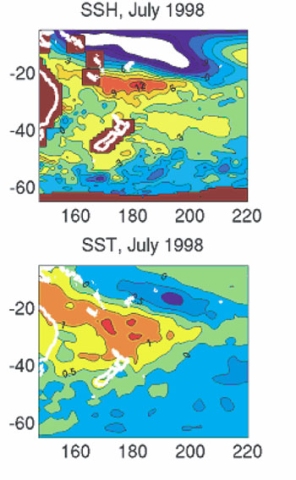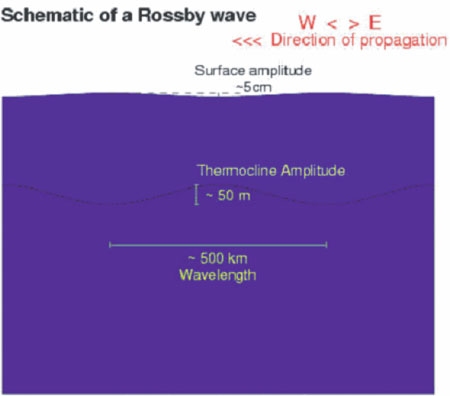Ocean signals after the 1997–98 El Niño
Dr Melissa Bowen and Dr Phil Sutton, NIWA
A series of warm events occurred in the Southwestern Pacific after the unusually strong 1997-98 El Niño. In 1998, record sea surface temperatures were measured around New Zealand, coral bleaching took place on the Great Barrier Reef, and a warming trend in the Tasman Sea increased. At the beginning of 1998, a region of elevated sea surface temperature formed, stretching southwest from the Queensland coast past New Zealand (Fig. 1). These elevated temperatures persisted for most of 1998. Temperature probes dropped from cargo ships travelling between Auckland and Suva show that the anomalously warm water extended to depths of nearly a kilometre below the surface. This suggests the thermocline, the interface between the warm upper kilometre of the ocean and the cold abyssal water below, had moved downward. Satellite measurements show a bulge in the sea surface height (Fig. 1) corresponding to the change in temperature at depth.
The thermocline can be pushed down when the wind piles water up on the surface. This triggers a Rossby wave that travels along the thermocline (Fig. 2). These waves have very long wavelengths and move very slowly from east to west, taking about a year to cross the South Fiji Basin. Using a simple model of wind-forced Rossby waves we have found that unusually strong easterlies during 1997 and 1998 depressed the thermocline and elevated the sea surface. As the wave travelled across the western Pacific the continued wind forcing added to the propagating signal, creating a large area of elevated sea surface height in the region of the South Fiji Basin. This high in the South Fiji Basin had almost disappeared by the end of 1998. In the model simulation this happened as the winds began to pull the thermocline upward and the original signal continued propagating to the west. In 2000, another warm event took place further north than the 1998 event and caused severe coral bleaching for many of the Pacific Islands. In the model simulation, the 2000 event was produced by a signal arriving from the central Pacific in contrast to the 1998 event that was strongly forced by the local winds in the western Pacific.
The model results should be regarded as one hypothesis about what has happened and what may happen in the southwestern Pacific. The model includes only simple ocean physics and the accuracy with which we can say it describes the event is limited by the length of time for which we have good ocean measurements. There is still considerable work to be done to untangle the ocean signals in the subtropics and their subsequent influences on the atmosphere and marine environment.


